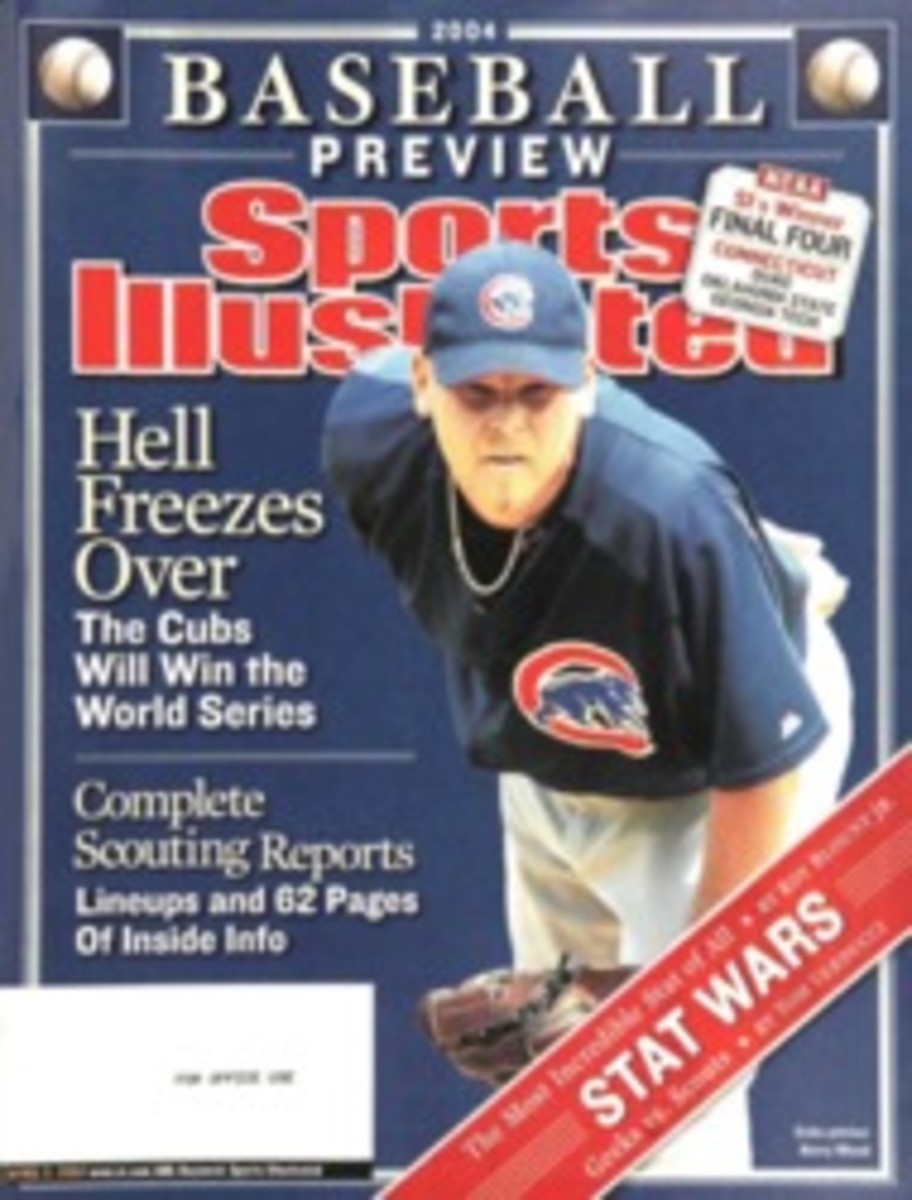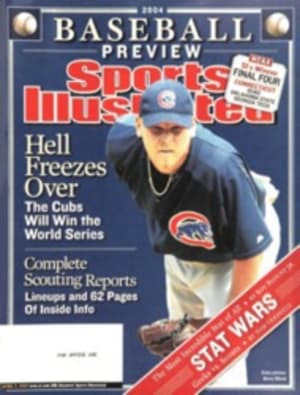
Does Clutch Hitting Truly Exist? Not in the stats community--but don't try telling that to the guys on the field
The most dangerous intersection of the artistic and scientific
views of baseball is the territory of clutch hitting--unless you
count the spot behind the Yankees' batting cage in Tampa, where
Mr. October himself has just been told that clutch hitting is, at
least in the statistical world, merely a myth.
"That could be the absolute dumbest thing I have ever heard in my
life," says Hall of Famer Reggie Jackson, a special instructor
for the Yankees and, having become eponymous with the ultimate
pressurized baseball month, the patron saint of clutch hitting.
Just then one of his disciples in the church of October, New York
shortstop Derek Jeter, walks by.
"And if there's anyone around like me, it's him," Jackson says.
"I was a home run hitter. He's a doubles guy. That's the only
difference. He's a different player when the game is on the
line."
But, Jeter is told later, clutch hitting doesn't exist because
the stat guys say.... "You can take those stat guys," Jeter
interrupts, "and throw them out the window."
Ho-kay. What we have here is a serious separation of church and
state, or, more specifically, those believers who've tried to
read the seams on a ninth-inning, 92-mph fastball with a
championship riding on their at bat and any deskbound,
number-crunching nonbeliever worth his correlation coefficient
who would sooner give credence to the tooth fairy than a clutch
hitter.
The case against defining clutch hitting as a skill, which has
been repeated in several studies, holds that there is no
statistical evidence to prove that some players "raise their
game" or "rise to the occasion" in clutch spots with any
consistency. For instance, a 1993 study by David Grabiner, a
statistician formerly at the University of Michigan, found that
"the correlation between past and current clutch performance is
.01, with a standard deviation of .07. In other words, there
isn't a significant ability in clutch hitting; if there were, the
same players would be good clutch hitters every year."
"There is such a thing as clutch hits," says Blue Jays assistant
general manager Keith Law, "but not clutch hitters. If you look
at the numbers and try to find that [clutch] hitter, you'll find
that he doesn't exist."
Jim Albert of the department of mathematics and statistics at
Bowling Green State University, in a 2001 report titled "Hitting
With Runners in Scoring Position," observed that although players
may have gaudy clutch-hitting numbers in a particular season,
"there appears to be little evidence that players have different
abilities to perform well in clutch situations [over the course
of their careers]."
For instance, according to the Elias Sports Bureau, one of the
greatest single-season clutch hitters over the past 30 years was
Phillies second baseman Manny Trillo, an otherwise mediocre, .263
career hitter. In 1981 Trillo batted .466 in what Elias defines
as late-inning pressure situations, or LIPS (charts, opposite).
Statisticians regard such a performance as an anomaly because of
the small sample size. (Trillo had 58 LIPS at bats that year.)
When Elias ran the career LIPS numbers for all players with a
minimum of 400 at bats in that situation over the past 30 years,
anomalies such as Trillo--whose career LIPS average excluding the
'81 season was .245--disappeared.
The 19 best career clutch hitters, led by Tony Gwynn's .358 in
LIPS, also happened to be good hitters overall. Fourteen of them
were career .300 hitters overall and none were worse than .285
(Mark Grudzielanek of the Cubs). Four of the 19 actually hit
worse in LIPS than overall while the other 15 improved their
batting average by no more than 8%. (Jason Kendall of the Pirates
improved the most in clutch spots, from .304 overall to .328 in
LIPS, trailing only Gwynn.) Essentially those hitters were about
as good in the clutch as they were overall.
Noted sabermetrician Bill James scoffed at clutch hitting as far
back as 1984, writing, "How is it that a player who possesses the
reflexes and the batting stroke and the knowledge and the
experience to be a .260 hitter in other circumstances magically
becomes a .300 hitter when the game is on the line? How does that
happen? What is the process? What are the effects? Until we can
answer those questions, I see little point in talking about
clutch ability."
To Jackson and Jeter, the most important answer for James is that
some players want those at bats with the game on the line more
than others.
"Are you telling me that when you're down to one shot, Michael
Jordan is no different from anybody else?" Jackson says. "How can
you tell me Tiger Woods doesn't play better under pressure? Jack
Nicklaus was the same as anybody else? I'm not buying it. It's
the same with Derek. Maybe his numbers don't go way up, but
everybody else's go down more. I've seen some great hitters, such
as Wade Boggs and Rod Carew, who didn't really like those spots."
Mr. October, by the way, was a .262 career hitter and batted .344
in postseason LIPS.
Says Jeter, "I've always enjoyed the big spots. Especially in the
postseason, your focus and concentration sharpen. Over a long
season, early in games, your mind has a tendency to wander. But
not with the game on the line. And once you're successful in
those spots, you know you can do it and look forward to it.
"With some guys you can tell by their expression and body
language that they'd rather not be up there. It seems like
they're scared of the situation. I've seen it. They walk
differently, carry themselves differently, look differently."
Jeter, whose 392 postseason at bats are second-most alltime, has
had nearly identical numbers in the postseason as he has in the
regular season, including batting average (.314 postseason, .317
regular season), on-base percentage (.385, .389) and slugging
percentage (.469, .462). In LIPS at bats, however, the Yankee
captain has been even better in the postseason: .415 versus .274.
"Now that says a lot," Yankees pitcher Mike Mussina says. "He's
putting up the same numbers or better against only the best
pitchers on the best teams in the most important games as he does
when facing Number 1 through 5 starters on not only the good
teams but also the below-average teams. Maybe it's a learned
skill. Experience is a big part of any skill, and he's been
through the postseason every year.
"As a pitcher I do know there's something to clutch hitting. I
see some guys come up in pressure situations, and you can tell
they're just trying not to strike out. I'm trying to take
advantage of a hitter's anxiety by getting him out on his front
foot to get him to roll over and hit a grounder or pop it up. The
good ones don't let that happen as easily. They don't expand the
strike zone, and they're willing to hit the ball up the middle or
to the opposite field. Magglio Ordonez is a good example."
Ordonez, a career .307 hitter with the White Sox, led all hitters
last year in LIPS batting (.456) and ranks third in those spots
over the past 30 years (.325).
"I do believe some guys are good at clutch hitting," Yankees
first baseman Jason Giambi says. "Derek Jeter is the reason I
believe it. I've hit behind him for two years, and I know in big
situations he takes better at bats. He shrinks his strike zone.
That's what makes him so good."
Says Sammy Sosa of the Cubs, "I really believe some people
concentrate better with the game on the line. That's money time.
You focus much better. Some people don't do great in those
situations. It doesn't mean he's not a good player. Me? I love
it. Always." Sosa, it should be noted, is worse in LIPS (.264)
than overall (.278).
Statistical analysts cringe at such heroic notions. Writes Joe
Sheehan of Baseball Prospectus, "It's this need to turn physics
and physicality into a statement about the character of people
... that is the most damning thing about the myth of clutch."
Moreover, memory and reputations can be misleading when it comes
to clutch hitting. David Justice, for instance, fashioned
something of a favorable October reputation largely because of
his home run in Game 6 of the 1995 World Series and his record
398 postseason at bats. Justice, however, hit .224 in postseason
LIPS, 27 points worse than his regular-season LIPS average.
"I always liked seeing Mark Lemke up there," Cubs pitcher Greg
Maddux says of his former Braves teammate. "He comes to mind when
I think about clutch hitters." Lemke, however, was a career .246
hitter overall and no better in LIPS at bats (.244).
So is clutch hitting myth or magic? It's like asking what's in
the water at Lourdes: It depends on who's answering. A Carmelite
nun, for instance, might find lacking the chemist's determination
that the water is nothing but two parts hydrogen to one part
oxygen; the chemist might scoff at the sister's belief in its
healing properties. According to two of the most statistically
oriented general managers in baseball, it may take both sides of
the brain--employing art and science--to properly define clutch
hitting.
"These are human beings playing the game," says Dodgers G.M. Paul
DePodesta. "There is a human element to this, including what
happens in what we deem to be pressure situations."
Says Red Sox G.M. Theo Epstein, "I'm torn. I know what the
numbers say, yet I admit when we have meetings and talk about
players as being clutch, I agree that there's something to it. I
admit it: I've got a foot in both camps." --T.V.
COLOR PHOTO: SHAUN BEST/REUTERS MR. OCTOBER JR. Jeter's postseason numbers impress, backing Reggie's boast that Derek is his clutch-hitting equal.
MONEY HITTERS
The charts below list the hitters who were the best in
late-inning pressure situations, or LIPS, in 2003 and those who
were the best over their careers (among players who debuted in
the majors in the past 30 years). The conclusion: While
significant improvement in pressure situations was common for one
season, the variations became much smaller over a career.
(Late-inning pressure situations: seventh inning or later with
the player's team trailing by three runs or less, or by four runs
or less with two or more men on base.)
LIPS LIPS LIPS NON-LIPS
2003 LEADERS* AB HITS BA BA DIFF.
Magglio Ordonez, White Sox 68 31 .456 .299 .157
Ken Harvey, Royals 54 23 .426 .246 .180
Carlos Baerga, Diamondbacks 53 22 .415 .318 .097
Scott Podsednik, Brewers 73 30 .411 .299 .112
Juan Pierre, Marlins 90 36 .400 .291 .109
LIPS LIPS LIPS NON-LIPS
CAREER LEADERS+ AB HITS BA BA DIFF.
Tony Gwynn, Padres 1,392 498 .358 .335 .023
Jason Kendall, Pirates 589 193 .328 .300 .028
Magglio Ordonez, White Sox 409 133 .325 .305 .020
Edgar Martinez, Mariners 822 266 .324 .314 .010
Nomar Garciaparra, Red Sox 493 158 .320 .323 -.003
*minimum 50 LIPS at bats
+minimum 400 LIPS at bats
Source: Elias Sports Bureau

